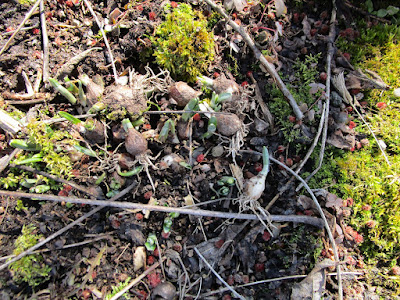More than one decade ago, we flew in the face of conventual wisdom and attempted to transplant Trailing Arbutus. Writings spanning the previous century described this native wonder as impossible to transplant. We discovered the hard way that these plants could be moved but their evergreen sweet foliage would likely be eaten by starved rabbits or woodchucks early in the year. A beneath the surface dry stone wall extending up along the wire cage edge has to date solved that problem. The appearance of this native plant's apparently wild placement is destroyed by the wire cage. In the past we would carefully remove fallen pine needles and oak leaves. Our treasured babies were given extensive care with the hope that they would survive. Not only have they survived, plants now extend past the limits of the cage. That exposed growth may be eaten but these plants are otherwise mostly on their own.

Many of the early flowering plants form their flower buds ahead of winter's arrival. A cursor click on the image will enlarge it and if you look just to the right of center near the lower edge of the photo you will see a cluster of buds. We find this promise of early flowers both exciting and reassuring. Why the squirrels or chipmunks did not carry off the acorn remains an unanswered question while the Arbutus looks great.

Cardinal Flower is another incredible native plant that is not commonly found in our area. The loss of snow cover has revealed a sizeable group of plants. The dead stems mark the location of last year's flowering plants and their need to increase the number of new plants now holding their spot. When the ground thaws these clusters can be unearthed. Gently pulling apart the plants, individuals can be transplanted into pots. When the snow cover first disappeared great looking plants are on display. The bitter cold that will surely visit here will likely turn these plants into dead mush. More to the north, snow cover exists for a longer period of time and the warm Georgia winds do not blow there. Here southern warmth followed by bitter cold often ends these native treasures.

We considered working among the plants but the ground is still frozen. This section of the driveway has taken a real beating. Where we can direct the running water to flow in the higher ditch, the situation improves. Flowing water softens the frozen soil and a deeper channel can then be established. We need to continue widening and deepening the ditch ahead of serious rainfall. With persistence and luck we may be able to at least reduce the amount of water roaring down the driveway. Last year we were able to use a shovel and lawn cart to move enough gravel to raise the road surface above the level of the ditch. We plan to do the same thing on this side after new gravel becomes available. For now it is dig, dig, dig. Happiness is being outside, working, getting the spring runoff to run downhill my way.


















